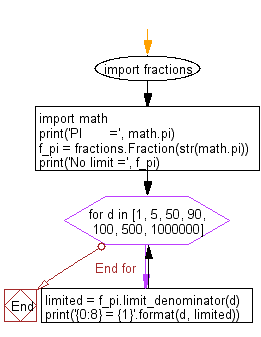Python Math: Convert a floating point number to an approximate rational value
Python Math: Exercise-47 with Solution
Write a Python program to convert a floating point number (PI) to an approximate rational value on the various denominator.
Note: max_denominator = 1000000
Sample Solution:-
Python Code:
import fractions
import math
print('PI =', math.pi)
f_pi = fractions.Fraction(str(math.pi))
print('No limit =', f_pi)
for d in [1, 5, 50, 90, 100, 500, 1000000]:
limited = f_pi.limit_denominator(d)
print('{0:8} = {1}'.format(d, limited))
Sample Output:
PI = 3.141592653589793
No limit = 3141592653589793/1000000000000000
1 = 3
5 = 16/5
50 = 22/7
90 = 267/85
100 = 311/99
500 = 355/113
1000000 = 3126535/995207
Flowchart:

Python Code Editor:
Have another way to solve this solution? Contribute your code (and comments) through Disqus.
Previous: Write a Python program to add, subtract, multiply and divide two fractions.
Next: Write a Python program to generate random float numbers in a specific numerical range.
What is the difficulty level of this exercise?
Test your Programming skills with w3resource's quiz.
Python: Tips of the Day
Find current directory and file's directory:
To get the full path to the directory a Python file is contained in, write this in that file:
import os dir_path = os.path.dirname(os.path.realpath(__file__))
(Note that the incantation above won't work if you've already used os.chdir() to change your current working directory, since the value of the __file__ constant is relative to the current working directory and is not changed by an os.chdir() call.)
To get the current working directory use
import os cwd = os.getcwd()
Documentation references for the modules, constants and functions used above:
- The os and os.path modules.
- The __file__ constant
- os.path.realpath(path) (returns "the canonical path of the specified filename, eliminating any symbolic links encountered in the path")
- os.path.dirname(path) (returns "the directory name of pathname path")
- os.getcwd() (returns "a string representing the current working directory")
- os.chdir(path) ("change the current working directory to path")
Ref: https://bit.ly/3fy0R6m
- New Content published on w3resource:
- HTML-CSS Practical: Exercises, Practice, Solution
- Java Regular Expression: Exercises, Practice, Solution
- Scala Programming Exercises, Practice, Solution
- Python Itertools exercises
- Python Numpy exercises
- Python GeoPy Package exercises
- Python Pandas exercises
- Python nltk exercises
- Python BeautifulSoup exercises
- Form Template
- Composer - PHP Package Manager
- PHPUnit - PHP Testing
- Laravel - PHP Framework
- Angular - JavaScript Framework
- Vue - JavaScript Framework
- Jest - JavaScript Testing Framework
